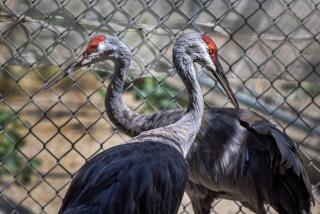Postscript : Ravaged Zoo Is Putting the Pieces Back Together : * Iraqis killed some of Kuwait’s collection during the Gulf War. A secret railroad saved others, and restoration is under way.
- Share via
KUWAIT CITY — Moosa Khashti was sitting in his office at the Iraqi-trashed Kuwait Zoo, wondering how he could repair the damage and replace the animals, when the phone rang.
“I’ve got your llamas,” the caller said.
“He took three llamas and kept them at his house,” the zoo director marveled, describing a kind of underground railroad that slipped rare birds and beasts--even two bears--out of their cages and into the safety of private homes during Iraqi occupation.
Bears? “Well, not our biggest,” Khashti explained. “Our two Syrian bears stayed here, and survived.” The Syrian is a fair-sized brown bear, the sort you see performing with Turkish circus troupes, a bit large to keep around the house. The two that took the railroad to safety were Malaysian sun bears, an odd-looking creature with a black ruff and a white blaze on its chest. But nonetheless a bear.
“They went to separate homes,” the director recalled. “Shortly after the war, a woman called and said, ‘Please come get your bear.’ ”
The underground railroad was about the only good news for the Kuwait Zoo during the seven-month occupation. Shortly after the invasion, about 250 Iraqi soldiers decided to use the open spaces of the zoo as a bivouac, setting up tents and opening a campaign of vandalism and cruelty.
Among other outrages, according to Khashti, the soldiers:
* Shot the elephant, once in the shoulder. The wound did not fell the big animal, and it was patched up by an American medical team when Kuwait was liberated.
* Killed all but a handful of the monkeys and apes. “Their bodies were lying everywhere, here and there around the grounds, when I came back,” Khashti said. About 10 baboons escaped the slaughter and were in their cage when the zoo staff returned.
One female that had been kept at a home has rejoined them. She chatters and reaches for passing workers at the still-unopened zoo. The others, who survived the ordeal, stay away from the bars, up in a rock structure, quiet and wary.
* Killed and barbecued the calf of a mating pair of Indian water buffaloes, born during the occupation. The Iraqis slaughtered most of the zoo’s antelopes, elands and gazelles for food, and chopped up the wooden fences for their cooking fires.
* Took the two-humped Bactrian camel and an Arabian oryx, a variety of antelope, off to Baghdad as war booty.
Khashti said he and his keepers were forced to leave the zoo after the Iraqis moved in, but young Kuwaitis began to go to the encampment and ask to feed the animals. The volunteers kept the animal collection alive with hard-to-get bread, vegetables and an occasional sheep for meat-eaters. The soldiers later permitted grazing animals to roam the grounds at night and feed off trees and bushes.
When the restrictions first loosened, the volunteers began slipping some animals into the underground railroad. A crowned crane was saved this way, along with a number of peacocks.
As the end neared for the occupation, the soldiers began to trash the zoo, smashing machinery and fixtures, burning the kitchen, stealing the air conditioners.
Now Khashti is trying to restore the zoo where he has worked for 19 years. Gone are the zebra, the reptiles, the ostrich--”Why the ostrich?” he asked--all killed. Two leopards and a puma died of starvation. But six of the eight lions survived, and the hippos.
“I’ve got my carnivores,” he said, “but I need monkeys,” and he’s contacting dealers and other zoos to see what he can obtain on a tight budget.
At one corner of the wrecked zoo stands the giraffe, staring down with its big brown eyes. A survivor. You wonder what it saw.
More to Read
Sign up for Essential California
The most important California stories and recommendations in your inbox every morning.
You may occasionally receive promotional content from the Los Angeles Times.












